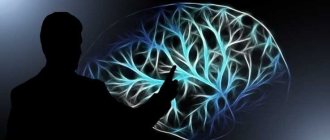The central nervous system regulates the functioning of the body as a whole, so violations of its function are always dangerous for humans. Early diagnosis of central nervous system diseases significantly increases the chances of recovery and reduces the risk of complications. In order to identify pathological changes in nerve cells, modern hardware examination methods are used: computer and magnetic resonance imaging. To determine the optimal diagnostic method, you need to know how CT differs from MRI of the brain.
CT angiography of cerebral vessels, three-dimensional image
Which is better: CT or MRI of the brain?
Tomography involves scanning the human body using X-rays or electromagnetic pulses. As a result of scanning the brain, a special computer program converts the response of the examined tissues into a series of layer-by-layer photographs reflecting changes in the structure, shape, and size of the organ being studied.
Each method has its own advantages; the decision to prescribe CT or MRI is made by the attending physician. The brain has a complex structure, pathological changes in any part lead to disruption of the vital functions of the whole organism, so the doctor chooses a diagnostic method based on the clinical manifestations of the process.
CT is used to determine the condition of solid elements, scan the skull bones, identify traumatic lesions, hematomas, and large areas of atherosclerosis. Computed tomography is informative regarding dense structures, and the examination process itself takes less time than MRI. The cost of CT is much lower than similar scanning using a magnetic field. The method is well suited for identifying neoplasms that develop with the involvement of bone elements. The use of contrast in brain examination increases the information content of tomography, allows for a detailed study of the state of the vascular system of the brain and differentiates between hemorrhages and bleeding in cases of skull injuries.
Comminuted fracture of the skull bones and a focus of contusion of the left hemisphere of the brain on CT
MRI is more informative when studying the condition of soft tissues and nerve fibers. The method gives a detailed picture of the state of the cerebral cortex, reflects the nature of the blood supply to this area, and reveals minor changes in the structure of the substance. Such scanning is indispensable in diagnosing malignant tumors in the early stages. Vascular MRI angiography visualizes disturbances in the blood supply to various areas and the consequences of ischemia of cerebral structures.
Brain cavernomas on MRI
The use of a magnetic field is harmless to the body, so MRI scanning can be performed repeatedly. This advantage is used when necessary to observe the process over time and monitor the effectiveness of treatment measures. The method is suitable for diagnosing brain pathologies in pregnant women, children and people who have contraindications to the use of X-ray radiation.
CT and MRI: what is the difference?
The tomographic method has been used for several decades as one of the most effective types of diagnostics, and often as the most effective
PCT is indispensable in the diagnosis of lungs, bones and hollow organs of the intestine, esophagus and urinary tract. A CT scanner provides detailed visualization of the structures of the area under study, thanks to which specialists can assess their condition and detect possible diseases, pathologies, neoplasms and mechanical damage. CT is performed in cases where other diagnostic methods are not reliable enough, and also if it is necessary to clarify the results of previous examinations.
Operating principle
These diagnostic methods are based on completely different physical phenomena, which affects the principles of operation of computed tomography and magnetic resonance imaging and their areas of application.
During CT diagnostics, organs and tissues absorb X-rays with different intensities, which is visualized in the resulting images. The principle of constructing CT images is the same as that of radiography, but CT is more effective than X-rays. Modern diagnostic centers use multislice CT scanners, which provide highly informative images and a reduced level of radiation exposure.
MRI is based on the interaction of an electromagnetic field with hydrogen atoms present in organs and tissues. This process is not accompanied by any radiation or unpleasant sensations, so MRI is completely safe and can be performed as often as indicated. As for the quality of diagnostics, the most informative images are provided by MRI devices with a magnetic field strength of at least 1.5 Tesla.
Both CT and MRI scanners provide thin-section scanning, which makes it possible to timely diagnose various diseases, pathologies and structural abnormalities, even at an early stage. With the help of modern devices, it is possible to examine tissues and organs in various projections, thanks to which specialists can assess the patient’s condition as accurately as possible and make a diagnosis in a short time.
Medical indications
CT and MRI are considered complementary diagnostic methods, since the main indications for their use differ significantly.
CT is indicated when the patient has:
- assessment of bone and tooth tissue;
- joint ruptures and injuries;
- bleeding;
- damage and structural pathologies of the spine;
- skull injuries of varying nature and complexity;
- assessment of the condition of the chest organs;
- assessment of the condition of hollow organs;
- diagnostics of the urinary system for the presence of stones.
The most common indications for MRI are:
- tumors, metastases, as well as suspicion of their presence;
- disturbances in the functioning of central nervous system structures;
- suspected damage or pathology of intracranial nerves;
- consequences of stroke;
- multiple sclerosis and its consequences;
- various injuries to ligaments, muscles, joints.
Research areas
Computed tomography is used primarily to assess the condition of bones and hollow organs. This type of diagnosis is optimal for examining the chest organs, especially the lungs, as well as for detecting kidney stones. CT is also performed for various injuries of bone tissue of any age and of a different nature, as well as when assessing their consequences. CT is informative in detecting metastatic processes affecting bone tissue.
MRI is most effective in studying the brain, spine, blood vessels, soft tissues, as well as in assessing the condition of parenchymal organs and joints. Magnetic resonance imaging is the optimal method for diagnosing tumors, since it allows not only to detect them, but also to clarify their nature, location, size and degree of interaction with nearby organs and tissues.
During MRI diagnostics, specialists can examine in detail the state of the central nervous system structures, as well as identify inflammation, abscesses, hernias, and cysts. MRI is often used as a clarifying method after ultrasound, CT or X-ray.
MRI does not contain X-ray radiation, so it is suitable for regular examinations and monitoring over time. CT images also show tumors and cysts, however, in cases where both of these methods are equally informative, MRI will be preferable if this type of diagnosis is not contraindicated for the patient.
Contraindications
CT scans are prescribed for children in cases where other diagnostic methods are uninformative. Since the children's body is sensitive to x-ray radiation, CT is performed only if the diagnostic value outweighs the possible risks. There is no health risk when performing an MRI, but during the examination you need to lie still for quite a long time, so this type of diagnosis is prescribed to children from 7 years old or carried out under anesthesia.
During CT examinations of blood vessels and internal organs, contrast is often used, which makes it possible to detail possible changes and clarify the diagnosis. However, patients with allergies to iodine and iodine-containing drugs, as well as patients with acute renal failure, do not undergo CT with contrast.
A common limitation for CT and MRI is pregnancy, however, there are some differences. CT scanning is contraindicated throughout pregnancy, since the fetus may be exposed to harmful X-ray radiation. MRI during pregnancy is not recommended only in the first trimester, since the effect of the magnetic field on the developing fetus has not yet been fully studied. However, a woman may be prescribed an MRI during pregnancy if it plays an important role in assessing her health.
Breastfeeding women are recommended to resume feeding no earlier than one day after undergoing diagnostics (both CT and MRI) with contrast.
Both MRI and CT scanners have a weight limit. This figure depends on the tomograph model, but most often it is 150 kg for a CT scanner and 120 kg for an MRI machine. In addition, it is worth paying attention to the volume of the patient’s body, since the aperture of closed-type tomographs is 60 cm.
It is important to lie still throughout the entire MRI examination, so for patients who for some reason cannot do this, an MRI with general anesthesia is recommended.
If there are metal structures in the patient's body (crowns, dental implants with metal), they will interact with magnetic waves, and artifacts may appear on MRI images.
Since the action of magnetic waves leads to life-threatening malfunctions of pacemakers, ear implants, and insulin pumps, the presence of these devices is an absolute contraindication to undergoing MRI.
Preparation and procedure
Before undergoing a CT scan with contrast, it is important for the patient to follow several preparation rules, thanks to which the study will be as informative as possible.
It is not recommended to eat for several hours before the examination. If general anesthesia is required, then it is better for the patient to abstain not only from food, but also from drinking drinks. After a CT scan with anesthesia, you need to make sure that the effect of the drug has completely worn off.
Before the examination, you must remove metal accessories and jewelry, as well as remove all metal objects from your pockets. If you have removable dentures and hearing aids, they should be removed for the duration of the diagnosis. If the patient has an allergy to any medications, this must also be reported before undergoing diagnostics.
On average, a CT scan without anesthesia and contrast lasts about 5-10 minutes; the introduction of contrast increases the duration of the study by about 15 minutes.
When performing a CT scan with contrast, you should drink more water on the day of the examination so that the process of removing the contrast drug from the body occurs more quickly.
In most cases, preliminary preparation for CT and MRI examinations is not necessary, however, there are important recommendations regarding the diagnosis of abdominal and pelvic organs:
- For 2-3 days, it is not recommended to eat foods that promote gas formation: cabbage, fruits, black bread. A few hours before the diagnosis, you should not eat or drink anything.
- The day before the test, you need to take a drug that reduces gas formation and relieves spasms (No-Spa or Espumisan is most often recommended).
- If an MRI examination of the bladder is required, it should not be emptied (the extent of its filling depends on the purpose of the examination).
To summarize: CT or MRI?
CT and MRI are complementary methods of examining the body, and each of them provides comprehensive information about the condition of the area under study. The choice of diagnostic method depends on the area of study and indications, so comparing CT and MRI is not always correct. The question of prescribing one or another type of diagnosis is decided by the doctor, and this decision will depend on the general picture of the disease, the patient’s complaints and the goals of the study.
How does an MRI differ from a CT scan of the brain?
The main difference between MRI and CT scan of the brain is the use of relevant physical phenomena to visualize the state of body tissues.
In a CT scan, the scan is done using x-rays. Hard and soft structures absorb ionizing radiation with different intensities, resulting in dark and light areas appearing on the film. They correspond to areas of reduced or increased hardness. By studying changes in the density of the structure of bone and cartilage tissue, it is possible to recreate a picture of the state of the studied area.
Unlike CT, MRI uses a magnetic field of varying intensity for scanning (which determines the power of the tomograph). It affects the location of water dipoles in the cells of the medulla. The response from fluid-saturated structures will be higher, so the information content of the method increases when scanning soft tissues. MRI of the brain shows minute changes in the brain matter, reflects demyelination processes, and reveals the growth and development of atypical cells.
Thanks to the use of a magnetic field, MRI does not have a negative effect on the human body, which distinguishes this method from computed tomography.
Contraindications for tomography
MRI and CT are considered safe procedures and therefore have virtually no contraindications. Even pregnant women can undergo computed tomography if they set the minimum radiation dose in the device settings. If all prescribed rules are followed, CT scanning will not harm patients diagnosed with cancer.
Contraindications to MRI are related to the peculiarities of the method itself. Magnetic resonance imaging is contraindicated
people who have
electronic devices
and
metal structures
. For example, pacemakers, implants and any devices that themselves transmit electrical impulses and can affect the impact of the magnetic field. In rare cases, a foreign metal body may accidentally enter the human body, for example, he may swallow a metal object. In such cases, the decision to carry out the procedure is made individually.
There are also some physiological limitations, but they are associated not so much with the procedure as such, but with the design features of the device. In particular, most CT and MRI machines are designed for patients whose weight does not exceed 170 kilograms.
There are no age restrictions for MRI and CT, but it must be taken into account that the MRI procedure can take a long time, and being in a static position for a long time will be a difficult test for the child. If the procedure is necessary, children under 5 years of age are often placed under general anesthesia or given a sedative.
Talking during the examination is not prohibited. On the contrary, the doctor himself often initiates a conversation with the patient in order to monitor his condition. The patient is also given a special block with a button that he can press if he feels his condition worsening.
In what cases is MRI of the brain prescribed?
Indications for head tomography are various pathological processes affecting the central nervous system and skull bones. The doctor analyzes the patient’s symptoms and complaints to choose the optimal diagnostic method: CT or MRI of the brain.
Magnetic resonance examination is carried out with the following clinical picture:
- headaches, dizziness, short-term loss of consciousness;
- the presence of paresis, decreased sensitivity of the tissues of the face, torso, and limbs;
- suspicion of the presence of neoplasms;
- signs of inflammation of the meninges;
- hearing impairment;
- decreased visual acuity;
- the appearance of sudden seizures;
- tingling, pain in the facial area;
- ischemic lesions of areas of the brain.
MRI is prescribed for conservative and surgical treatment of central nervous system diseases to monitor effectiveness. For malignant tumors, the method allows one to monitor the process of tumor development and determine the results of therapeutic and surgical effects on malignant areas.
Thanks to MRI, the following pathological processes affecting various parts of the brain are determined:
- benign and malignant formations of soft tissues, brain matter and its membranes, cranial nerves, vascular tumors;
- inflammatory processes – encephalitis, meningitis, abscess;
- organic lesions – encephalopathy, etc.;
- congenital developmental anomalies;
- cerebral ischemia in the acute stage and consequences of hemorrhagic stroke;
- degenerative processes - Alzheimer's, Pick's, Parkinson's diseases;
- demyelinating pathologies - multiple sclerosis, etc.
Diseases accompanied by changes in the structure of the brain matter are detected in the early stages thanks to magnetic resonance imaging. Scanning parts of the brain in the axial, sagittal and frontal planes provide a clear picture of the condition of soft tissues and fluid structures. Based on a series of photographs of the study area, a 3D model of the study area can be constructed.
Germinoma of the brain, MRI image
In what cases is a CT scan of the brain prescribed?
Tumors of the cerebral cortex can deform and thin the bones of the skull and grow into nearby sinuses. In this case, computed tomography reveals changes in solid structures, allows you to localize the process and determine its nature.
Brain injuries are often associated with damage to bone tissue, which performs a protective function. The formation of hematomas and hemorrhages can also be a consequence of mechanical damage.
Such conditions require prompt diagnosis and effective treatment. To identify pathological changes in the bone and cartilaginous structures of the skull and assess the nature of the blood supply to the brain, the doctor may prescribe computed tomography, which is a fast and accurate diagnostic method.
CT is indicated in the following cases:
- open and closed skull injuries;
- headaches, dizziness of unknown etiology;
- history of inflammatory processes in the area of the meninges;
- previously diagnosed strokes, cysts, brain abscesses;
- suspicion of the presence of neoplasms;
- changes in the shape of the skull;
- unexplained neurological symptoms (convulsions, fainting);
- suspicion of the presence of a foreign body in the cranial cavity;
- possible hematoma, cerebral edema;
- hemorrhagic stroke in acute and subacute stages;
- suspicion of the existence of cerebral vascular anomalies (aneurysms, arteriovenous malformations).
The presence of contraindications to the use of a magnetic field in the diagnosis of diseases of the central nervous system is also the reason for prescribing CT.
Using computed tomography, the following pathologies are determined:
- fractures, cracks of the skull bones;
- hemorrhages and hematomas due to any reason;
- benign and malignant formations involving bone and cartilaginous structures;
- cerebral aneurysms;
- strokes.
A CT scan of the brain is performed with contrast, which allows one to see the characteristics of the blood supply to this area and identify pathologies of the vascular system.
Consequences of hemorrhagic cerebral stroke on CT
What is more informative, CT or MRI of the brain?
The information content of each method depends on the area of application and the task set by the attending physician.
Computed tomography visualizes the condition of bone and cartilage structures, with its help the nature of damage in head injuries is determined, the condition of blood vessels is assessed and some brain tumors are identified. For soft tissues, the method is less informative, since they have weak radiopacity.
The reliability of CT scanning can be increased by using a contrast agent administered intravenously. The solution enters the bloodstream and highlights the vascular system of the scanned area in the image. Such a study is relevant in the presence of neoplasms that have their own special network of arterioles, aneurysms, especially if a rupture is suspected, arteriovenous malformations, arterial sinus anastomosis.
MRI displays in detail the condition of soft tissues, membranes of the brain and its substance, and nerve fibers. The quality of the image when scanning with an electromagnetic field depends on the saturation of the tissue with liquid. The use of a contrast solution increases the information content of the method in relation to focal brain pathology.
Magnetic resonance imaging detects malignant processes at an early stage.
Can I undergo an MRI or CT scan if I wish?
As a rule, a doctor gives a referral for an MRI or CT scan based on clinical indications, but medical centers are ready to conduct examinations on a paid basis even without a doctor’s referral. This is legal and not dangerous to the health of patients, so people can sign up and undergo the procedure of their own free will. The question is expediency. If you really need an examination, then your attending physician will tell you about it, and if it is not necessary, then why pay money and undergo body screening? It is unlikely that the results obtained will be useful to you.
However, there are also “risk groups”. If a person is at risk for any disease that can be detected in the early stages using MRI or CT, then undergoing preventive examinations will be useful. For example, lung cancer can be detected in the early stages.










